Optimizing Quality and Shelf-Life Extension of Bor-Thekera (Garcinia pedunculata) Juice: A Thermosonication Approach with Artificial Neural Network Modeling
Abstract
1. Introduction
2. Materials and Methods
2.1. Juice Preparation
2.2. Pasteurization of the Juice
2.3. Thermosonication of the Juice
2.4. Storage Study
2.5. Determination of Physicochemical Properties
2.5.1. pH, Total Soluble Solids (TSSs), and Titratable Acidity (TA)
2.5.2. Cloudiness (CI) and Browning Indexes (BI)
2.6. Determination of Functional Properties
2.6.1. Total Phenolic Content (TPC) and Total Flavonoid Content (TFC)
2.6.2. Antioxidant Activity (AO)
2.6.3. Ascorbic Acid Content (AAC)
2.7. Microbial Analysis
2.8. ANN Experimental Modeling
Genetic Algorithm (GA) Optimization
2.9. Statistical Analysis
3. Results and Discussion
3.1. pH
3.2. TSSs
3.3. TA
3.4. The Impacts of Pasteurization and Thermosonication on Cloudiness of Bor-Thekera Juice
3.5. The Impacts of Pasteurization and Thermosonication on Browning Index (BI) of Bor-Thekera Juice
3.6. The Impacts of Pasteurization and Thermosonication on the TPC and TFC of Bor-Thekera Juice
3.7. The Impacts of Pasteurization and Thermosonication on the Antioxidant Activity of Bor-Thekera Juice
3.8. The Impacts of Pasteurization and Thermosonication on the Ascorbic Acid Content (AAC) of Bor-Thekera Juice
3.9. The Impacts of Pasteurization and Thermosonication on Microbial Populations of Bor-Thekera Juice
Total Viable Count (TVC) and Yeast and Mold Count (YMC)
3.10. GA Optimization and Modeling of Thermosonicated Bor-Thekera Juice Using ANN
4. Conclusions
Author Contributions
Funding
Institutional Review Board Statement
Informed Consent Statement
Data Availability Statement
Conflicts of Interest
References
- Bhattacharjee, S.; Devi, R. A Comprehensive Review of Garcinia Pedunculata Roxb. and Its Therapeutic Potential. Mini-Rev. Med. Chem. 2021, 21, 3113–3143. [Google Scholar] [CrossRef] [PubMed]
- Sen, S. Meyna Spinosa Roxb.: An Unexplored Ethnomedicinal Plant. Int. J. Green. Pharm. IJGP 2017, 11, 332–337. [Google Scholar] [CrossRef]
- Abdullah, N.; Chin, N.L. Application of Thermosonication Treatment in Processing and Production of High Quality and Safe-to-Drink Fruit Juices. Agric. Agric. Sci. Procedia 2014, 2, 320–327. [Google Scholar] [CrossRef]
- Petruzzi, L.; Campaniello, D.; Speranza, B.; Corbo, M.R.; Sinigaglia, M.; Bevilacqua, A. Thermal Treatments for Fruit and Vegetable Juices and Beverages: A Literature Overview. Compr. Rev. Food Sci. Food Saf. 2017, 16, 668–691. [Google Scholar] [CrossRef] [PubMed]
- Das, P.; Nayak, P.K.; Stephen Inbaraj, B.; Sharma, M.; Kesavan, R.K.; Sridhar, K. Effect of Thermosonication on the Nutritional Quality of Lapsi (Choerospondias Axillaris) Fruit Juice: Application of Advanced Artificial Neural Networks. Foods 2023, 12, 3723. [Google Scholar] [CrossRef] [PubMed]
- Krishnan Kesavan, R.; Begum, S.; Das, P.; Nayak, P.K. Hurdle Effect of Thermosonication and Non-Thermal Processing on the Quality Characteristics of Fruit Juices: An Overview. J. Food Process Eng. 2023, 46, e14310. [Google Scholar] [CrossRef]
- Das, P.; Nayak, P.K.; Kesavan, R.k. Ultrasound Assisted Extraction of Food Colorants: Principle, Mechanism, Extraction Technique and Applications: A Review on Recent Progress. Food Chem. Adv. 2022, 1, 100144. [Google Scholar] [CrossRef]
- Anaya-Esparza, L.M.; Méndez-Robles, M.D.; Sayago-Ayerdi, S.G.; García-Magaña, M.d.L.; Ramírez-Mares, M.V.; Sánchez-Burgos, J.A.; Montalvo-González, E. Effect of Thermosonication on Pathogenic Bacteria, Quality Attributes and Stability of Soursop Nectar during Cold Storage. CyTA J. Food 2017, 15, 592–600. [Google Scholar] [CrossRef]
- Das, P.S.; Nayak, P.K.; Senthilnathan, K.; Das, P.; Kesavan, R.k. Optimization of Thermosonication Treatments to Improve the Quality Parameters of Posotia (Vitex Negundo) Juice. J. Agric. Food Res. 2023, 14, 100811. [Google Scholar] [CrossRef]
- Koshani, R.; Ziaee, E.; Niakousari, M.; Golmakani, M.T. Optimization of Thermal and Thermosonication Treatments on Pectin Methyl Esterase Inactivation of Sour Orange Juice (Citrus Aurantium). J. Food Process Preserv. 2015, 39, 567–573. [Google Scholar] [CrossRef]
- Wahia, H.; Zhou, C.; Mustapha, A.T.; Amanor-Atiemoh, R.; Mo, L.; Fakayode, O.A.; Ma, H. Storage Effects on the Quality Quartet of Orange Juice Submitted to Moderate Thermosonication: Predictive Modeling and Odor Fingerprinting Approach. Ultrason. Sonochem 2020, 64, 104982. [Google Scholar] [CrossRef] [PubMed]
- Alves, L.d.L.; dos Santos, R.L.; Bayer, B.L.; Devens, A.L.M.; Cichoski, A.J.; Mendonça, C.R.B. Thermosonication of Tangerine Juice: Effects on Quality Characteristics, Bioactive Compounds, and Antioxidant Activity. J. Food Process Preserv. 2020, 44, e14914. [Google Scholar] [CrossRef]
- Bayati, M.; Manzari Tavakoli, M.; Nejad Ebrahimi, S.; Aliahmadi, A.; Rezadoost, H. Optimization of Effective Parameters in Cold Pasteurization of Pomegranate Juice by Response Surface Methodology and Evaluation of Physicochemical Characteristics. LWT 2021, 147, 111679. [Google Scholar] [CrossRef]
- Nayak, P.K.; Chandrasekar, C.M.; Gogoi, S.; Kesavan, R.k. Impact of Thermal and Thermosonication Treatments of Amora (Spondius Pinnata) Juice and Prediction of Quality Changes Using Artificial Neural Networks. Biosyst. Eng. 2022, 223, 169–181. [Google Scholar] [CrossRef]
- Wu, Y.; Xu, L.; Liu, X.; Hasan, K.M.F.; Li, H.; Zhou, S.; Zhang, Q.; Zhou, Y. Effect of Thermosonication Treatment on Blueberry Juice Quality: Total Phenolics, Flavonoids, Anthocyanin, and Antioxidant Activity. LWT 2021, 150, 112021. [Google Scholar] [CrossRef]
- Mala, T.; Sadiq, M.B.; Anal, A.K. Optimization of Thermosonication Processing of Pineapple Juice to Improve the Quality Attributes during Storage. J. Food Meas. Charact. 2021, 15, 4325–4335. [Google Scholar] [CrossRef]
- Yıkmış, S.; Aksu, H.; Çöl, B.G.; Alpaslan, M. Thermosonication Processing of Quince (Cydonia Oblonga) Juice: Effects on Total Phenolics, Ascorbic Acid, Antioxidant Capacity, Color and Sensory Properties. Ciência E Agrotecnologia 2019, 43, e019919. [Google Scholar] [CrossRef]
- Nayak, P.K.; Basumatary, B.; Chandrasekar, C.M.; Seth, D.; Kesavan, R.K. Impact of Thermosonication and Pasteurization on Total Phenolic Contents, Total Flavonoid Contents, Antioxidant Activity, and Vitamin C Levels of Elephant Apple (Dillenia Indica) Juice. J. Food Process Eng. 2020, 43, e13447. [Google Scholar] [CrossRef]
- Aadil, R.M.; Zeng, X.A.; Han, Z.; Sun, D.W. Effects of Ultrasound Treatments on Quality of Grapefruit Juice. Food Chem. 2013, 141, 3201–3206. [Google Scholar] [CrossRef]
- Kesavan, R.K.; Gogoi, S.; Nayak, P.K. Influence of Thermosonication and Pasteurization on the Quality Attributes of Kutkura (Meyna Spinosa) Juice. Appl. Food Res. 2023, 3, 100268. [Google Scholar] [CrossRef]
- Cervantes-Elizarrarás, A.; Piloni-Martini, J.; Ramírez-Moreno, E.; Alanís-García, E.; Güemes-Vera, N.; Gómez-Aldapa, C.A.; Zafra-Rojas, Q.Y.; Cruz-Cansino, N.D.S. Enzymatic Inactivation and Antioxidant Properties of Blackberry Juice after Thermoultrasound: Optimization Using Response Surface Methodology. Ultrason. Sonochem 2017, 34, 371–379. [Google Scholar] [CrossRef]
- Nayak, P.K.; Chandrasekar, C.M.; Kesavan, R.K. Effect of Thermosonication on the Quality Attributes of Star Fruit Juice. J. Food Process Eng. 2018, 41, e12857. [Google Scholar] [CrossRef]
- Cerreti, M.; Liburdi, K.; Benucci, I.; Emiliani Spinelli, S.; Lombardelli, C.; Esti, M. Optimization of Pectinase and Protease Clarification Treatment of Pomegranate Juice. LWT Food Sci. Technol. 2017, 82, 58–65. [Google Scholar] [CrossRef]
- Pradhan, D.; Abdullah, S.; Pradhan, R.C. Chironji (Buchanania Lanzan) Fruit Juice Extraction Using Cellulase Enzyme: Modelling and Optimization of Process by Artificial Neural Network and Response Surface Methodology. J. Food Sci. Technol. 2021, 58, 1051–1060. [Google Scholar] [CrossRef] [PubMed]
- Patel, G.; Patra, A.; Abdullah, S.; Dwivedi, M. Indian Jujube (Ziziphus Mauritiana L.) Fruit Juice Extraction Using Cellulase Enzyme: Modelling and Optimization of Approach by ANN-GA. Appl. Food Res. 2022, 2, 100080. [Google Scholar] [CrossRef]
- Martínez-Flores, H.E.; Garnica-Romo, M.G.; Bermúdez-Aguirre, D.; Pokhrel, P.R.; Barbosa-Cánovas, G.V. Physico-Chemical Parameters, Bioactive Compounds and Microbial Quality of Thermo-Sonicated Carrot Juice during Storage. Food Chem. 2015, 172, 650–656. [Google Scholar] [CrossRef] [PubMed]
- Gani, A.; Baba, W.N.; Ahmad, M.; Shah, U.; Khan, A.A.; Wani, I.A.; Masoodi, F.A.; Gani, A. Effect of Ultrasound Treatment on Physico-Chemical, Nutraceutical and Microbial Quality of Strawberry. LWT Food Sci. Technol. 2016, 66, 496–502. [Google Scholar] [CrossRef]
- Adiamo, O.Q.; Ghafoor, K.; Al-Juhaimi, F.; Mohamed Ahmed, I.A.; Babiker, E.E. Effects of Thermosonication and Orange By-Products Extracts on Quality Attributes of Carrot (Daucus Carota) Juice during Storage. Int. J. Food Sci. Technol. 2017, 52, 2115–2125. [Google Scholar] [CrossRef]
- Abid, M.; Jabbar, S.; Wu, T.; Hashim, M.M.; Hu, B.; Saeeduddin, M.; Zeng, X. Qualitative Assessment of Sonicated Apple Juice during Storage. J. Food Process Preserv. 2015, 39, 1299–1308. [Google Scholar] [CrossRef]
- Nadulski, R.; Masłowski, A.; Mazurek, A.; Sobczak, P.; Szmigielski, M.; Żukiewicz-Sobczak, W.; Niedziółka, I.; Mazur, J. Vitamin C and Lutein Content of Northern Highbush Blueberry (Vaccinium Corymbosum L.) Juice Processed Using Freezing and Thawing. J. Food Meas. Charact. 2019, 13, 2521–2528. [Google Scholar] [CrossRef]
- Feng, M.; Chitrakar, B.; Chen, J.; Islam, M.N.; Wei, B.; Wang, B.; Zhou, C.; Ma, H.; Xu, B. Effect of Multi-Mode Thermosonication on the Microbial Inhibition and Quality Retention of Strawberry Clear Juice during Storage at Varied Temperatures. Foods 2022, 11, 2593. [Google Scholar] [CrossRef]
- Santhirasegaram, V.; Razali, Z.; Somasundram, C. Effects of Thermal Treatment and Sonication on Quality Attributes of Chokanan Mango (Mangifera Indica L.) Juice. Ultrason. Sonochem 2013, 20, 1276–1282. [Google Scholar] [CrossRef]
- Del Socorro Cruz-Cansino, N.; Ramírez-Moreno, E.; León-Rivera, J.E.; Delgado-Olivares, L.; Alanís-García, E.; Ariza-Ortega, J.A.; De Jesús Manríquez-Torres, J.; Jaramillo-Bustos, D.P. Shelf Life, Physicochemical, Microbiological and Antioxidant Properties of Purple Cactus Pear (Opuntia Ficus Indica) Juice after Thermoultrasound Treatment. Ultrason. Sonochem 2015, 27, 277–286. [Google Scholar] [CrossRef]
- Mustapha, A.T.; Zhou, C.; Sun, Y.; Wahia, H.; Sarpong, F.; Owusu-Ansah, P.; Osae, R.; Otu, P.; Ma, H. Simultaneous Multifrequency: A Possible Alternative to Improve the Efficacy of Ultrasound Treatment on Cherry Tomato during Storage. J. Food Process Preserv. 2019, 43, e14083. [Google Scholar] [CrossRef]
- Sulaiman, A.; Farid, M.; Silva, F.V.M. Strawberry Puree Processed by Thermal, High Pressure, or Power Ultrasound: Process Energy Requirements and Quality Modeling during Storage. Food Sci. Technol. Int. 2016, 23, 293–309. [Google Scholar] [CrossRef] [PubMed]
- Wang, J.; Wang, J.; Ye, J.; Vanga, S.K.; Raghavan, V. Influence of High-Intensity Ultrasound on Bioactive Compounds of Strawberry Juice: Profiles of Ascorbic Acid, Phenolics, Antioxidant Activity and Microstructure. Food Control 2019, 96, 128–136. [Google Scholar] [CrossRef]
- Oliveira, G.A.R.; Guimarães, J.T.; Ramos, G.L.P.A.; Esmerino, E.A.; Pimentel, T.C.; Neto, R.P.C.; Tavares, M.I.B.; Sobral, L.A.; Souto, F.; Freitas, M.Q.; et al. Benefits of Thermosonication in Orange Juice Whey Drink Processing. Innov. Food Sci. Emerg. Technol. 2022, 75, 102876. [Google Scholar] [CrossRef]
- Ruiz-De Anda, D.; Ventura-Lara, M.G.; Rodríguez-Hernández, G.; Ozuna, C. The Impact of Power Ultrasound Application on Physicochemical, Antioxidant, and Microbiological Properties of Fresh Orange and Celery Juice Blend. J. Food Meas. Charact. 2019, 13, 3140–3148. [Google Scholar] [CrossRef]
- Kumar, S.; Pipliya, S.; Srivastav, P.P. Effect of Cold Plasma Processing on Physicochemical and Nutritional Quality Attributes of Kiwifruit Juice. J. Food Sci. 2023, 88, 1533–1552. [Google Scholar] [CrossRef]



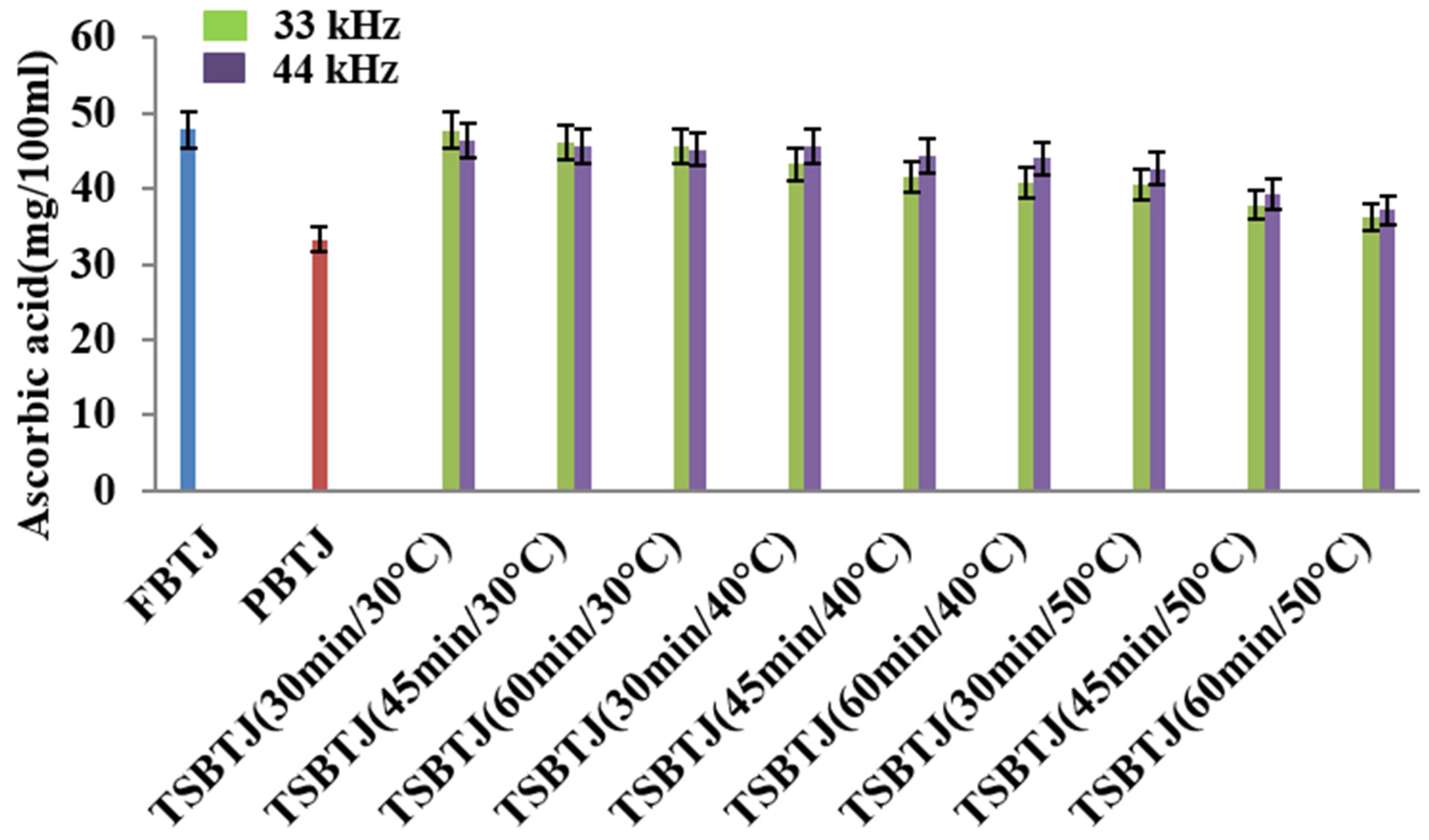
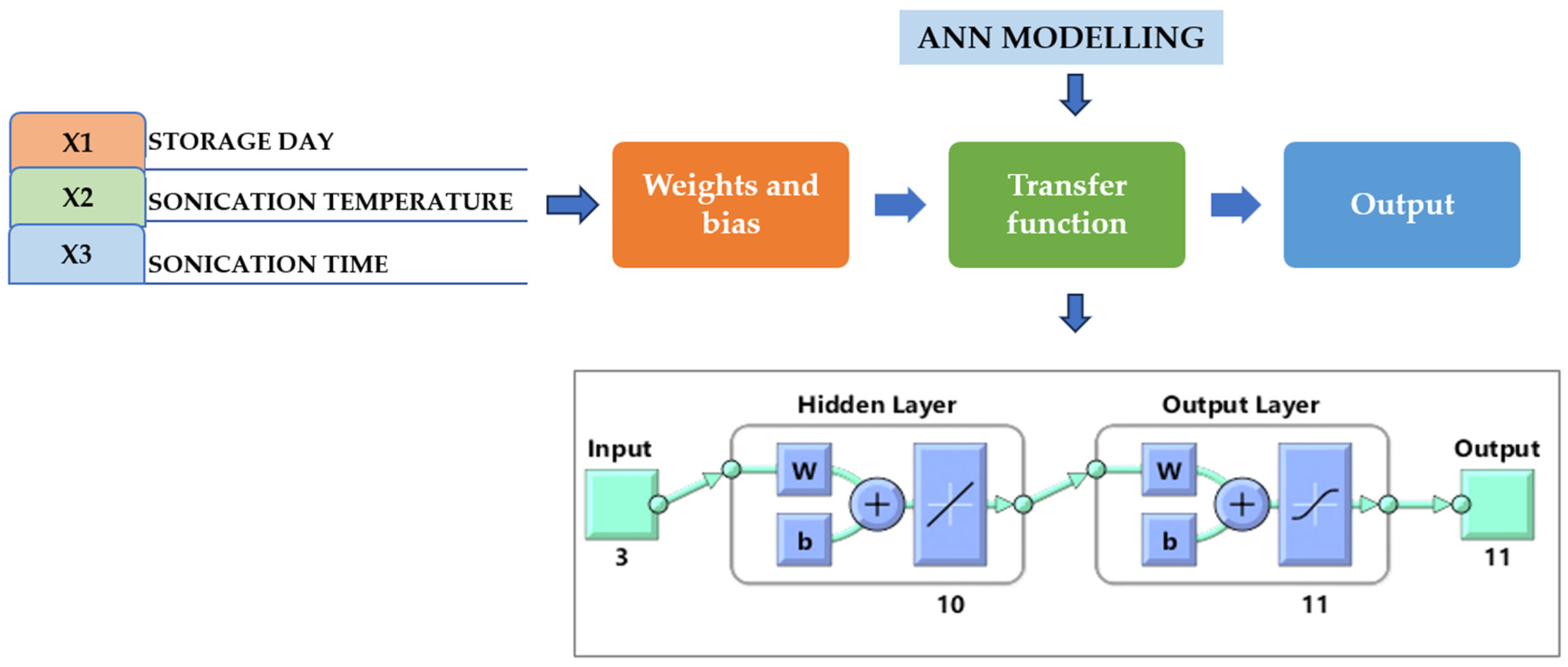
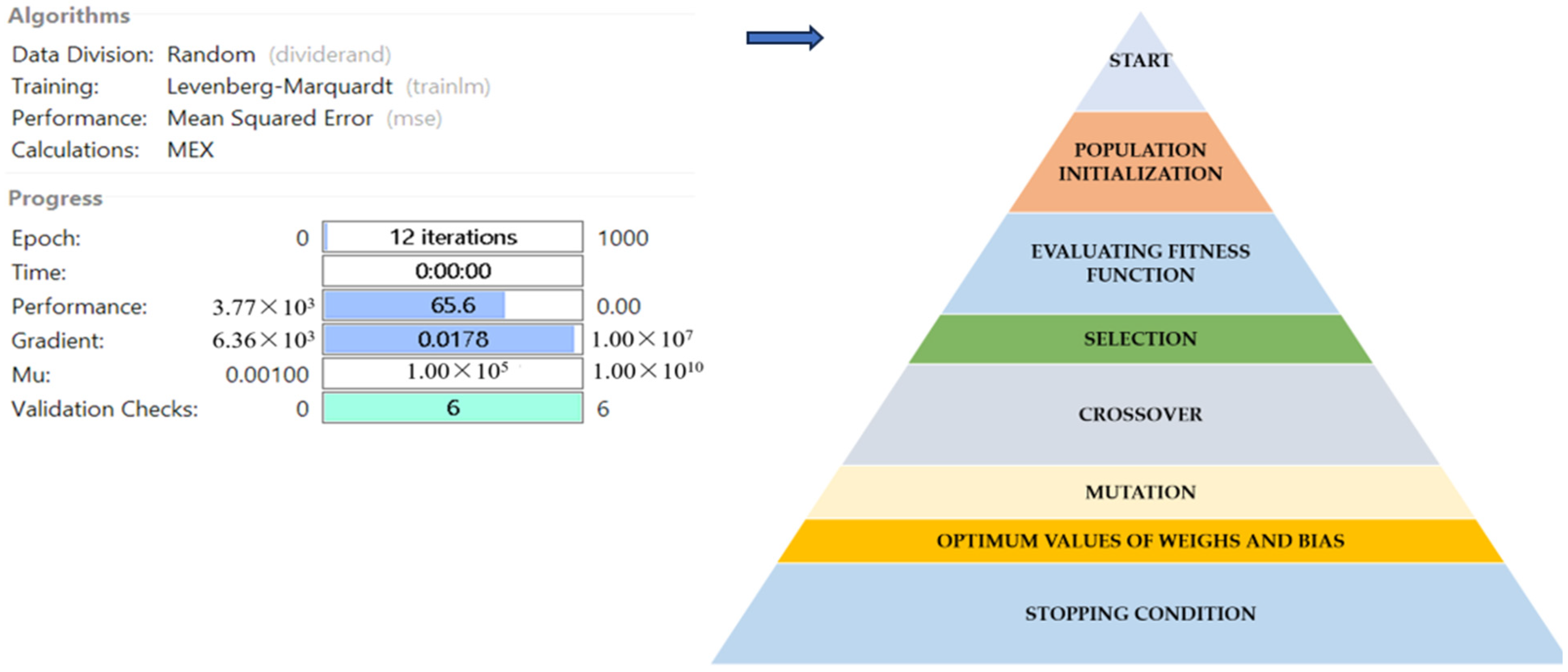
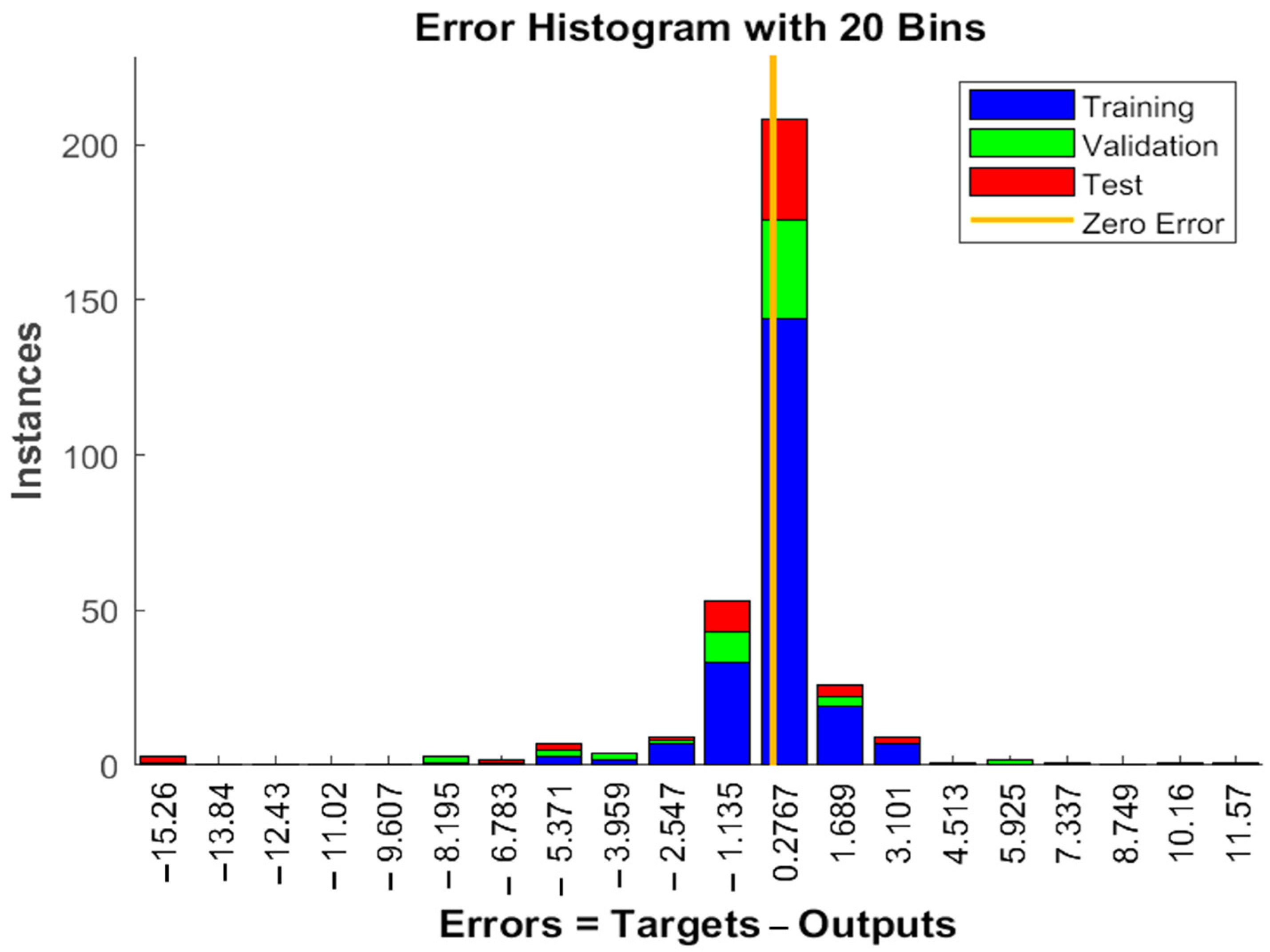
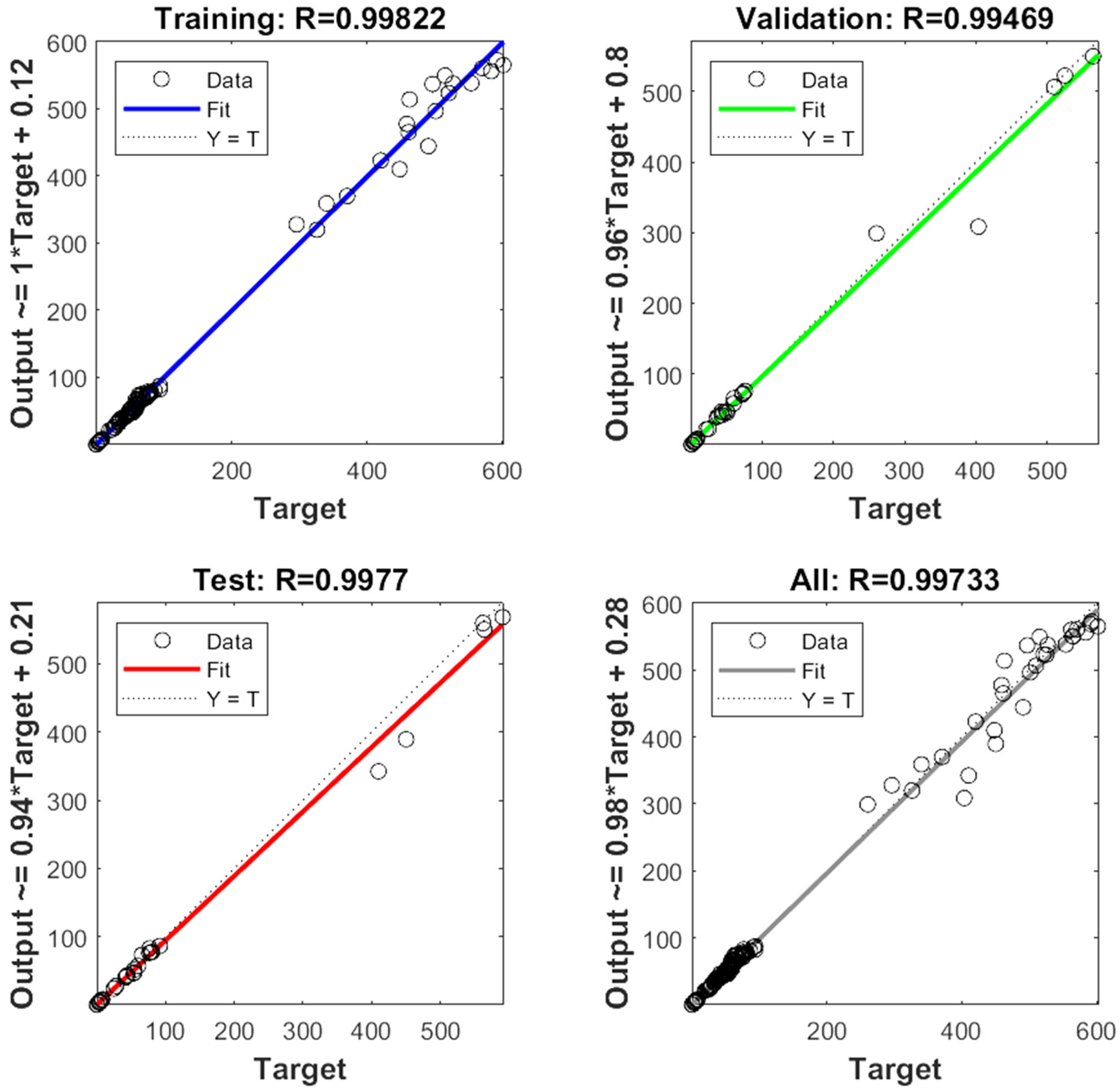
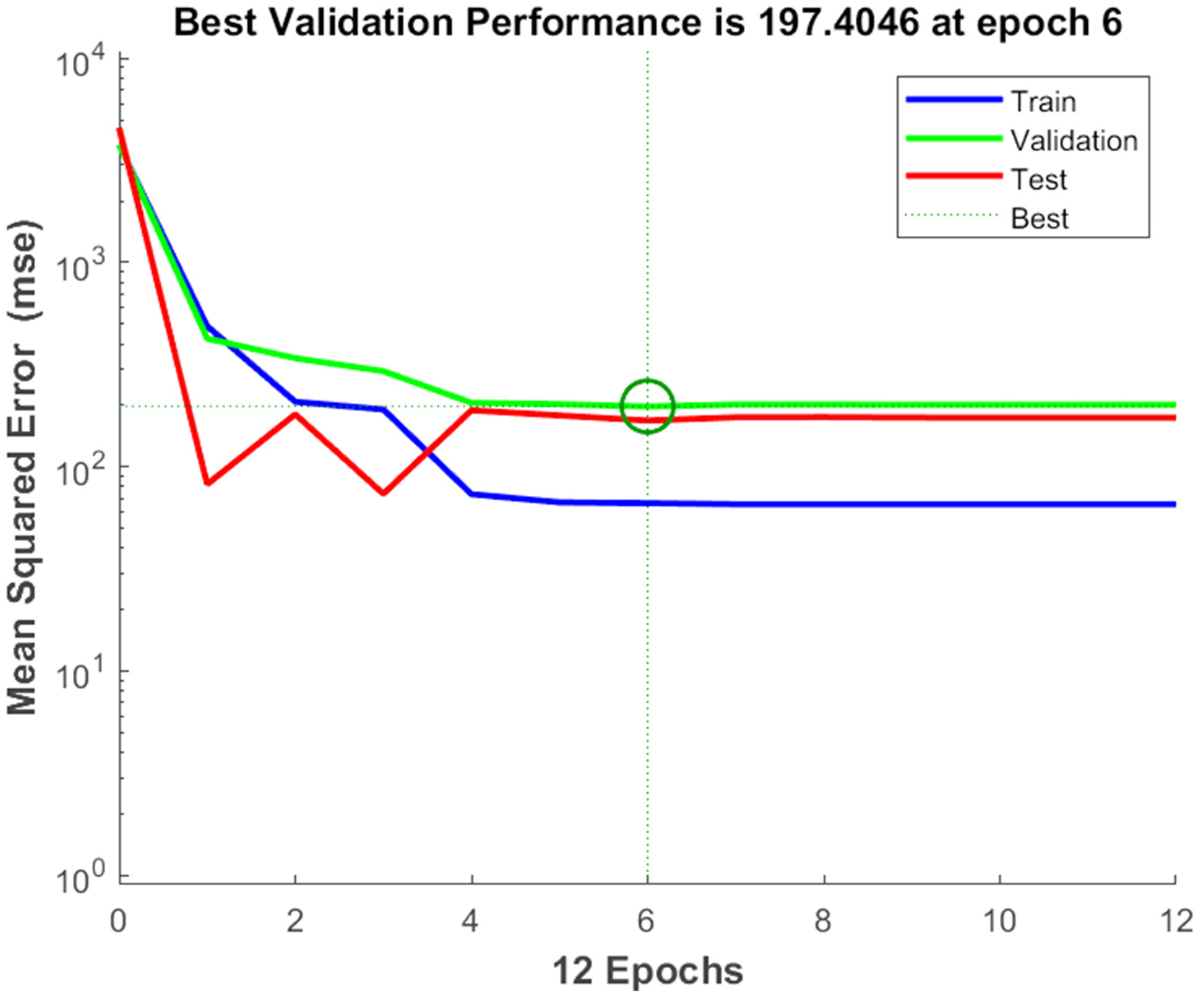
| Treatment/Condition | pH | TSSs (°Brix) | TA (%) | Cloudiness | Browning Index |
|---|---|---|---|---|---|
| FBTJ | 2.91 ± 0.05 a | 6.13 ± 0.13 a | 0.548 ± 0.016 a | 0.0357 ± 0.0013 a | 0.0318 ± 0.010 a |
| PBTJ | 3.15 ± 0.03 b | 6.13 ± 0.13 a | 0.540 ± 0.017 ab | 0.0290 ± 0.0019 bcd | 0.0361 ± 0.014 a |
| TSBTJ (30 min/30 °C) | 2.93 ± 0.04 ac | 6.24 ± 0.17 a | 0.533 ± 0.011 abc | 0.0308 ± 0.0016 b | 0.0479 ± 0.011 a |
| TSBTJ (45 min/30 °C) | 3.04 ± 0.02 adc | 6.27 ± 0.18 a | 0.520 ± 0.017 abcd | 0.0265 ± 0.0013 cde | 0.0543 ± 0.014 a |
| TSBTJ (60 min/30 °C) | 3.12 ± 0.06 bd | 6.39 ± 0.16 ab | 0.514 ± 0.012 abcd | 0.0231 ± 0.0018 e | 0.0583 ± 0.012 a |
| TSBTJ (30 min/40 °C) | 2.94 ± 0.04 ac | 6.35 ± 0.19 ab | 0.499 ± 0.011 bcd | 0.0292 ± 0.0014 bcd | 0.0526 ± 0.013 a |
| TSBTJ (45 min/40 °C) | 3.03 ± 0.03 dc | 6.87 ± 0.13 bc | 0.502 ± 0.013 cd | 0.0251 ± 0.0016 de | 0.0587 ± 0.013 a |
| TSBTJ (60 min/40 °C) | 3.12 ± 0.02 bd | 6.92 ± 0.18 c | 0.494 ± 0.014 cde | 0.0243 ± 0.0013 e | 0.0591 ± 0.012 a |
| TSBTJ (30 min/50 °C) | 2.98 ± 0.05 ab | 6.79 ± 0.14 c | 0.494 ± 0.012 cde | 0.0298 ± 0.0012 bc | 0.0542 ± 0.011 a |
| TSBTJ (45 min/50 °C) | 3.10 ± 0.03 cd | 7.00 ± 0.16 c | 0.484 ± 0.013 de | 0.0253 ± 0.0014 de | 0.0579 ± 0.016 a |
| TSBTJ (60 min/50 °C) | 3.13 ± 0.03 ab | 7.06 ± 0.19 c | 0.455 ± 0.011 e | 0.0242 ± 0.0011 e | 0.0598 ± 0.014 a |
| Treatment/Condition | pH | TSSs (°Brix) | TA (%) | Cloudiness | Browning Index |
|---|---|---|---|---|---|
| FBTJ | 2.91 ± 0.05 d | 6.13 ± 0.13 d | 0.548 ± 0.016 a | 0.0357 ± 0.0013 a | 0.0318 ± 0.010 a |
| PBTJ | 3.15 ± 0.03 a | 6.13 ± 0.13 d | 0.540 ± 0.017 ab | 0.0290 ± 0.0019 b | 0.0361 ± 0.014 a |
| TSBTJ (30 min/30 °C) | 2.95 ± 0.02 cd | 6.30 ± 0.17 cd | 0.535 ± 0.018 ab | 0.0296 ± 0.0017 b | 0.0480 ± 0.012 a |
| TSBTJ (45 min/30 °C) | 3.05 ± 0.05 abc | 6.35 ± 0.14 cd | 0.517 ± 0.012 abc | 0.0241 ± 0.0016 bc | 0.0525 ± 0.013 a |
| TSBTJ (60 min/30 °C) | 3.10 ± 0.04 ab | 6.43 ± 0.14 cd | 0.512 ± 0.011 abcd | 0.0227 ± 0.0015 bcd | 0.0589 ± 0.011 a |
| TSBTJ (30 min/40 °C) | 2.92 ± 0.03 d | 6.56 ± 0.16 bcd | 0.504 ± 0.014 bcd | 0.0259 ± 0.0013 bcde | 0.0512 ± 0.015 a |
| TSBTJ (45 min/40 °C) | 3.07 ± 0.05 ab | 6.73 ± 0.12 abc | 0.499 ± 0.016 bcd | 0.0222 ± 0.0016 cde | 0.0570 ± 0.011 a |
| TSBTJ (60 min/40 °C) | 3.10 ± 0.03 ab | 6.89 ± 0.19 ab | 0.489 ± 0.012 cd | 0.0214 ± 0.0012 de | 0.0584 ± 0.010 a |
| TSBTJ (30 min/50 °C) | 3.01 ± 0.02 bcd | 7.03 ± 0.16 a | 0.484 ± 0.016 cd | 0.0273 ± 0.0011 de | 0.0568 ± 0.009 a |
| TSBTJ (45 min/50 °C) | 3.09 ± 0.05 ab | 7.08 ± 0.14 a | 0.481 ± 0.017 cd | 0.0257 ± 0.0015 de | 0.0583 ± 0.006 a |
| TSBTJ (60 min/50 °C) | 3.13 ± 0.04 a | 7.10 ± 0.17 a | 0.470 ± 0.011 d | 0.0218 ± 0.0017 e | 0.0594 ± 0.014 a |
| SDs | Time | TT | PH | TSSs | TA | CI | BI | AO | AAC | TPC | TFC | TVC | YM |
|---|---|---|---|---|---|---|---|---|---|---|---|---|---|
| 0 | 30 | 40 | 2.92 | 6.56 | 0.49 | 0.026 | 0.051 | 79.48 | 45.64 | 583.73 | 67.96 | 3.86 | 3.77 |
| 0 | 45 | 40 | 3.07 | 6.73 | 0.50 | 0.022 | 0.057 | 81.27 | 44.32 | 601.62 | 93.85 | 3.73 | 3.53 |
| 0 | 60 | 40 | 3.10 | 6.89 | 0.49 | 0.021 | 0.058 | 81.18 | 43.98 | 592.21 | 93.87 | 3.74 | 3.46 |
| 1 | 30 | 40 | 3.01 | 6.63 | 0.47 | 0.025 | 0.055 | 76.19 | 44.31 | 564.18 | 65.48 | 3.92 | 4.13 |
| 1 | 45 | 40 | 3.09 | 7.03 | 0.46 | 0.022 | 0.059 | 78.22 | 43.21 | 570.53 | 85.93 | 3.79 | 3.71 |
| 1 | 60 | 40 | 3.11 | 7.09 | 0.46 | 0.020 | 0.060 | 80.40 | 42.75 | 590.94 | 91.56 | 3.81 | 3.70 |
| 3 | 30 | 40 | 3.10 | 6.82 | 0.46 | 0.023 | 0.055 | 75.79 | 43.98 | 554.18 | 62.31 | 4.00 | 4.19 |
| 3 | 45 | 40 | 3.13 | 7.16 | 0.46 | 0.021 | 0.059 | 75.52 | 42.79 | 564.75 | 75.46 | 3.94 | 3.76 |
| 3 | 60 | 40 | 3.17 | 7.20 | 0.45 | 0.020 | 0.061 | 78.61 | 41.69 | 562.42 | 76.84 | 3.93 | 3.77 |
| 5 | 30 | 40 | 3.17 | 7.14 | 0.46 | 0.022 | 0.055 | 74.26 | 42.56 | 521.08 | 61.21 | 4.08 | 4.28 |
| 5 | 45 | 40 | 3.19 | 7.29 | 0.45 | 0.020 | 0.059 | 74.18 | 39.78 | 527.38 | 75.40 | 3.94 | 3.78 |
| 5 | 60 | 40 | 3.20 | 7.34 | 0.43 | 0.019 | 0.062 | 75.82 | 39.59 | 515.38 | 75.78 | 3.96 | 3.81 |
| 7 | 30 | 40 | 3.17 | 7.27 | 0.46 | 0.022 | 0.060 | 71.85 | 38.76 | 510.14 | 59.47 | 4.62 | 4.41 |
| 7 | 45 | 40 | 3.21 | 7.47 | 0.45 | 0.020 | 0.060 | 72.28 | 36.15 | 525.19 | 59.89 | 4.02 | 4.25 |
| 7 | 60 | 40 | 3.24 | 7.56 | 0.43 | 0.018 | 0.062 | 75.27 | 35.88 | 496.95 | 62.92 | 3.99 | 4.22 |
| 10 | 30 | 40 | 3.18 | 7.35 | 0.45 | 0.021 | 0.060 | 69.92 | 36.08 | 458.94 | 56.01 | 4.69 | 4.47 |
| 10 | 45 | 40 | 3.24 | 7.51 | 0.44 | 0.019 | 0.061 | 68.43 | 35.78 | 501.48 | 57.51 | 4.12 | 4.32 |
| 10 | 60 | 40 | 3.26 | 7.61 | 0.42 | 0.017 | 0.063 | 63.77 | 32.79 | 463.13 | 58.18 | 4.01 | 4.29 |
| 15 | 30 | 40 | 3.21 | 7.49 | 0.44 | 0.021 | 0.060 | 58.36 | 34.19 | 420.46 | 54.92 | 4.71 | 4.63 |
| 15 | 45 | 40 | 3.25 | 7.64 | 0.43 | 0.019 | 0.062 | 63.70 | 33.27 | 490.91 | 56.36 | 4.31 | 4.50 |
| 15 | 60 | 40 | 3.28 | 7.69 | 0.41 | 0.016 | 0.064 | 61.09 | 29.68 | 461.52 | 55.39 | 4.25 | 4.44 |
| 20 | 30 | 40 | 3.24 | 7.56 | 0.43 | 0.020 | 0.061 | 52.67 | 28.77 | 370.77 | 50.29 | 4.78 | 4.76 |
| 20 | 45 | 40 | 3.28 | 7.72 | 0.42 | 0.018 | 0.062 | 60.12 | 27.91 | 450.36 | 54.34 | 4.46 | 4.64 |
| 20 | 60 | 40 | 3.31 | 7.84 | 0.41 | 0.016 | 0.064 | 61.00 | 26.05 | 448.39 | 52.68 | 4.49 | 4.61 |
| 25 | 30 | 40 | 3.27 | 7.58 | 0.42 | 0.018 | 0.062 | 48.50 | 27.62 | 296.20 | 47.13 | 4.86 | 4.92 |
| 25 | 45 | 40 | 3.34 | 7.94 | 0.42 | 0.017 | 0.063 | 54.35 | 24.78 | 410.17 | 53.67 | 4.50 | 4.67 |
| 25 | 60 | 40 | 3.38 | 8.29 | 0.41 | 0.015 | 0.064 | 58.64 | 23.22 | 340.12 | 50.51 | 4.59 | 4.65 |
| 30 | 30 | 40 | 3.33 | 7.77 | 0.40 | 0.017 | 0.062 | 42.17 | 24.31 | 260.42 | 45.43 | 4.94 | 5.03 |
| 30 | 45 | 40 | 3.39 | 8.16 | 0.40 | 0.015 | 0.063 | 49.05 | 20.79 | 403.59 | 50.50 | 4.82 | 4.88 |
| 30 | 60 | 40 | 3.41 | 8.41 | 0.39 | 0.015 | 0.065 | 51.57 | 19.14 | 326.27 | 49.30 | 4.78 | 4.84 |
| Treatment/Condition | TVC (log CFU/mL) | YMC (log CFU/mL) | TVC (log CFU/mL) | YMC (log CFU/mL) |
|---|---|---|---|---|
| FBTJ | 3.95 ± 0.03 a | 3.79 ± 0.04 a | 3.95 ± 0.03 a | 3.79 ± 0.04 a |
| PBTJ | Not detected | Not detected | Not detected | Not detected |
| Frequency | 33 kHz | 44 kHz | ||
| TSBTJ (30 min/30 °C) | 3.92 ± 0.03 ab | 3.75 ± 0.03 ab | 3.88 ± 0.02 ab | 3.72 ± 0.04 ab |
| TSBTJ (45 min/30 °C) | 3.90 ± 0.02 ab | 3.73 ± 0.03 ab | 3.81 ± 0.03 b | 3.67 ± 0.03 bc |
| TSBTJ (60 min/30 °C) | 3.88 ± 0.03 abc | 3.71 ± 0.02 ab | 3.76 ± 0.03 bc | 3.59 ± 0.03 bc |
| TSBTJ (30 min/40 °C) | 3.91 ± 0.04 abcd | 3.73 ± 0.04 ab | 3.86 ± 0.03 bcd | 3.67 ± 0.02 bc |
| TSBTJ (45 min/40 °C) | 3.88 ± 0.03 abcd | 3.70 ± 0.03 ab | 3.73 ± 0.02 cde | 3.53 ± 0.03 cd |
| TSBTJ (60 min/40 °C) | 3.86 ± 0.02 bcd | 3.69 ± 0.02 b | 3.71 ± 0.04 de | 3.46 ± 0.04 de |
| TSBTJ (30 min/50 °C) | 3.86 ± 0.01 bcd | 3.71 ± 0.01 b | 3.84 ± 0.03 de | 3.65 ± 0.03 de |
| TSBTJ (45 min/50 °C) | 3.82 ± 0.03 cd | 3.69 ± 0.03 b | 3.74 ± 0.02 e | 3.51 ± 0.02 e |
| TSBTJ (60 min/50 °C) | 3.81 ± 0.03 d | 3.67 ± 0.02 b | 3.70 ± 0.03 e | 3.44 ± 0.04 e |
| SDs | Time | TT | PH | TSSs | TA | CI | BI | AO | AA | TPC | TFC | TVC | YM |
|---|---|---|---|---|---|---|---|---|---|---|---|---|---|
| 0 | 30 | 40 | 3.05 | 6.83 | 0.48 | 0.020 | 0.062 | 76.61 | 43.62 | 555.86 | 75.73 | 3.99 | 3.89 |
| 0 | 45 | 40 | 3.09 | 6.95 | 0.47 | 0.022 | 0.057 | 77.45 | 42.91 | 564.90 | 82.61 | 3.91 | 3.76 |
| 0 | 60 | 40 | 3.14 | 7.10 | 0.45 | 0.023 | 0.053 | 78.14 | 41.98 | 572.32 | 87.44 | 3.85 | 3.66 |
| 1 | 30 | 40 | 3.06 | 6.86 | 0.48 | 0.020 | 0.062 | 76.03 | 43.33 | 550.44 | 73.21 | 4.01 | 3.93 |
| 1 | 45 | 40 | 3.10 | 6.98 | 0.47 | 0.022 | 0.057 | 76.95 | 42.52 | 560.39 | 80.63 | 3.92 | 3.79 |
| 1 | 60 | 40 | 3.15 | 7.14 | 0.45 | 0.023 | 0.053 | 77.73 | 41.48 | 568.63 | 86.13 | 3.86 | 3.69 |
| 3 | 30 | 40 | 3.07 | 6.91 | 0.48 | 0.019 | 0.062 | 74.67 | 42.63 | 538.00 | 67.99 | 4.05 | 4.04 |
| 3 | 45 | 40 | 3.12 | 7.06 | 0.46 | 0.021 | 0.057 | 75.79 | 41.62 | 549.94 | 76.08 | 3.95 | 3.88 |
| 3 | 60 | 40 | 3.17 | 7.23 | 0.45 | 0.023 | 0.053 | 76.75 | 40.34 | 559.98 | 82.88 | 3.88 | 3.75 |
| 5 | 30 | 40 | 3.09 | 6.98 | 0.47 | 0.019 | 0.062 | 73.04 | 41.75 | 523.36 | 62.91 | 4.09 | 4.15 |
| 5 | 45 | 40 | 3.14 | 7.14 | 0.46 | 0.020 | 0.057 | 74.39 | 40.50 | 537.42 | 70.98 | 3.98 | 3.98 |
| 5 | 60 | 40 | 3.20 | 7.32 | 0.45 | 0.022 | 0.053 | 75.55 | 38.98 | 549.45 | 78.77 | 3.90 | 3.83 |
| 7 | 30 | 40 | 3.11 | 7.05 | 0.47 | 0.018 | 0.062 | 71.14 | 40.66 | 506.51 | 58.41 | 4.14 | 4.27 |
| 7 | 45 | 40 | 3.17 | 7.22 | 0.46 | 0.020 | 0.057 | 72.71 | 39.17 | 522.68 | 65.77 | 4.02 | 4.08 |
| 7 | 60 | 40 | 3.22 | 7.42 | 0.44 | 0.021 | 0.053 | 74.09 | 37.41 | 536.83 | 73.94 | 3.93 | 3.92 |
| 10 | 30 | 40 | 3.15 | 7.17 | 0.47 | 0.017 | 0.061 | 67.81 | 38.62 | 477.47 | 53.20 | 4.21 | 4.44 |
| 10 | 45 | 40 | 3.20 | 7.36 | 0.45 | 0.019 | 0.057 | 69.69 | 36.78 | 496.47 | 58.70 | 4.08 | 4.26 |
| 10 | 60 | 40 | 3.25 | 7.56 | 0.44 | 0.020 | 0.053 | 71.40 | 34.72 | 513.74 | 66.13 | 3.98 | 4.08 |
| 15 | 30 | 40 | 3.20 | 7.41 | 0.46 | 0.016 | 0.061 | 61.39 | 34.26 | 422.96 | 48.37 | 4.34 | 4.68 |
| 15 | 45 | 40 | 3.25 | 7.61 | 0.44 | 0.017 | 0.056 | 63.54 | 32.06 | 444.25 | 50.91 | 4.20 | 4.54 |
| 15 | 60 | 40 | 3.29 | 7.80 | 0.43 | 0.019 | 0.053 | 65.65 | 29.89 | 465.14 | 55.19 | 4.07 | 4.37 |
| 20 | 30 | 40 | 3.25 | 7.65 | 0.45 | 0.016 | 0.061 | 55.04 | 29.44 | 370.05 | 46.46 | 4.47 | 4.84 |
| 20 | 45 | 40 | 3.29 | 7.83 | 0.43 | 0.016 | 0.056 | 57.01 | 27.43 | 389.41 | 47.43 | 4.33 | 4.75 |
| 20 | 60 | 40 | 3.33 | 7.99 | 0.42 | 0.018 | 0.053 | 59.09 | 25.66 | 409.99 | 49.24 | 4.19 | 4.63 |
| 25 | 30 | 40 | 3.29 | 7.87 | 0.44 | 0.015 | 0.061 | 49.96 | 25.32 | 327.86 | 45.78 | 4.59 | 4.94 |
| 25 | 45 | 40 | 3.33 | 8.02 | 0.42 | 0.016 | 0.056 | 51.43 | 23.88 | 342.41 | 46.13 | 4.46 | 4.88 |
| 25 | 60 | 40 | 3.35 | 8.14 | 0.41 | 0.017 | 0.053 | 53.08 | 22.72 | 358.97 | 46.79 | 4.32 | 4.81 |
| 30 | 30 | 40 | 3.33 | 8.05 | 0.43 | 0.015 | 0.060 | 46.56 | 22.51 | 299.19 | 45.55 | 4.68 | 4.98 |
| 30 | 45 | 40 | 3.35 | 8.16 | 0.42 | 0.015 | 0.056 | 47.49 | 21.64 | 308.64 | 45.67 | 4.58 | 4.96 |
| 30 | 60 | 40 | 3.37 | 8.24 | 0.41 | 0.016 | 0.053 | 48.59 | 20.98 | 319.95 | 45.90 | 4.45 | 4.92 |
| R2 | 0.984 | 0.973 | 0.970 | 0.995 | 0.980 | 0.992 | 0.998 | 0.990 | 0.970 | 0.994 | 0.985 | ||
| MSE | 0.386 | 0.370 | 0.118 | 0.688 | 0.487 | 0.188 | 0.141 | 0.805 | 0.591 | 0.169 | 0.587 | ||
| MAE | 0.013 | 0.013 | 0.004 | 0.024 | 0.017 | 0.006 | 0.005 | 0.028 | 0.020 | 0.006 | 0.020 | ||
Disclaimer/Publisher’s Note: The statements, opinions and data contained in all publications are solely those of the individual author(s) and contributor(s) and not of MDPI and/or the editor(s). MDPI and/or the editor(s) disclaim responsibility for any injury to people or property resulting from any ideas, methods, instructions or products referred to in the content. |
© 2024 by the authors. Licensee MDPI, Basel, Switzerland. This article is an open access article distributed under the terms and conditions of the Creative Commons Attribution (CC BY) license (https://creativecommons.org/licenses/by/4.0/).
Share and Cite
Gogoi, S.; Das, P.; Nayak, P.K.; Sridhar, K.; Sharma, M.; Sari, T.P.; Kesavan, R.k.; Bhaswant, M. Optimizing Quality and Shelf-Life Extension of Bor-Thekera (Garcinia pedunculata) Juice: A Thermosonication Approach with Artificial Neural Network Modeling. Foods 2024, 13, 497. https://doi.org/10.3390/foods13030497
Gogoi S, Das P, Nayak PK, Sridhar K, Sharma M, Sari TP, Kesavan Rk, Bhaswant M. Optimizing Quality and Shelf-Life Extension of Bor-Thekera (Garcinia pedunculata) Juice: A Thermosonication Approach with Artificial Neural Network Modeling. Foods. 2024; 13(3):497. https://doi.org/10.3390/foods13030497
Chicago/Turabian StyleGogoi, Shikhapriyom, Puja Das, Prakash Kumar Nayak, Kandi Sridhar, Minaxi Sharma, Thachappully Prabhat Sari, Radha krishnan Kesavan, and Maharshi Bhaswant. 2024. "Optimizing Quality and Shelf-Life Extension of Bor-Thekera (Garcinia pedunculata) Juice: A Thermosonication Approach with Artificial Neural Network Modeling" Foods 13, no. 3: 497. https://doi.org/10.3390/foods13030497
APA StyleGogoi, S., Das, P., Nayak, P. K., Sridhar, K., Sharma, M., Sari, T. P., Kesavan, R. k., & Bhaswant, M. (2024). Optimizing Quality and Shelf-Life Extension of Bor-Thekera (Garcinia pedunculata) Juice: A Thermosonication Approach with Artificial Neural Network Modeling. Foods, 13(3), 497. https://doi.org/10.3390/foods13030497









